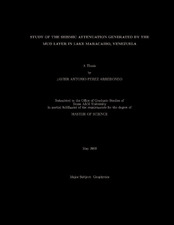| dc.description.abstract | Several seismic properties of Lake Maracaibo are unique and difficult to understand. However, studies show that the two principal factors that affect the seismic data are likely to be the low compressional and shear wave velocities generated by the gassy sediment in the mud layer, and the high attenuation of the compressional and shear waves. This mud layer sediment is heavy and is not suspended in the water. Furthermore, it is compacted enough to support shear stresses and, therefore, has a finite shear wave velocity.
In theory, the gas content of the sediment reduces the compressional wave velocity by an order of magnitude below the values for water saturated sediments, but in Lake Maracaibo several studies show that gassy sediment reduces the compressional wave velocity from 1500 m/s to between 300 m/s and 700 m/s. This situation produces high attenuation of the compressional waves that are traveling through the sediment in the first 100 m. However, the results of seismic modeling show that this velocity has to be between 700 m/s and 900 m/s in order to get reasonable results, at least in the study area.
The results show that there are very important lithological differences between the zones with and without gassy sediments in the mud layer. The best match between the raw data and the synthetic seismogram was found when an embedded rigid shale layer was located within the mud layer, in the first 100 m. Unrealistic results were produced when the rigid shale layer was removed in the modeling. This rigid layer produces a destructive interference in the Stoneley wave that could be observed in the seismic data and the synthetic seismogram.
In this research, the attenuation quality factor Q, an intrinsic property of rock, will be studied. Common attenuation mechanisms include grain sliding, viscous flow of pore fluid or gas, viscous relaxation and other features. Additionally, it will be shown that other factors can be proposed to account for the attenuation of compressional and shear waves in Lake Maracaibo sediments. They include: the viscous losses between the particles and the fluid immediately above the mud layer; and the solid friction losses between the particles, the mud layer and the gassy sediment. This research shows
That the attenuation in the mud layer in the zone with gassy sediment is very different from the attenuation in the zone without gassy sediment, and that the compressional wave attenuation is larger in the mud layer zone with gassy sediment than in the mud layer zone without gassy sediment. Finally, the research shows that the ringing is an important phenomenon associated with the low velocity in the mud layer and that this ringing has more frequency content in the zone without gassy sediment than in the zone with gassy sediment. | en |


